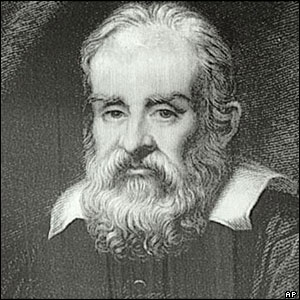Faithen S. & Mackenzie M. & Tiani J.

Image copyright: http://upload.wikimedia.org/wikipedia/commons/b/b6/Galileo_Galilei_4.jpg
Galileo was born in Pisa, Italy on February 15, 1564.
His parents were Vincenzo Galilei and Guilia Ammannati.
Before Galileo was born his parents had once been one of the most powerful families in Florence. But his parents fell into poverty when Galileo was born, so he grew up very poor.
Galileo\'s father was a musician and when him and his wife met, they moved to Pisa and had their first born child, Galileo. When Vincenzo died, he left heavy financial responsibilities to his oldest son with no assets.
Galileo\'s discoveries started during his early years but his fame out lived him.
Galileo was one of the first people to realize that the speed at which an object falls is not related to its weight. The understanding of how gravity works.
He built the first telescope capable of observing the night sky.
He found that the Earth is NOT the center of the universe.
He discovered the moons of Jupiter and other facts about the solar system. He contributed to science by discovering ballistics, calculations still used today.
Galileo died January 8, 1642 at the age of 78 years old.
EDUCATION:
Galileo was tutored in Pisa until the age of 10,but then returned to Florence in 1575.
He enrolled in 1581 as a medical student, but left without a degree.
Galileo found interest in mathematics and left Pisa to study this PRIVATELY.
Galileo was Catholic and was tried by the Inquisition in 1615, he was later condemned to living the rest of his life under house arrest. All of this was for Copernicanism, not for any heretical theological views.
WORK EXPERIENCE:
He wanted to work as a math professor at the University of Bologna, but the job was offered to people with a higher experience. He wound up getting hired to teach at the University of Pisa.
The university later on didn\'t renew his contract because students claimed he was too hard to work with.
In the year 1604, he instructed the Duke of Mantua on how to operate a geometric and military compass.
Galilei also worked as an author. He wrote a total of seven books, but only published six.
In 1611, Federigo Cesi entered him into the Accademia dei Lincei, which published several of his books.
Galileo also worked as an inventor, he improved equipment in Hydraulics, Military, Engineering, Cartography, and Navigation.
AWARDS AND ACHIEVEMENTS:
Galileo Galilei invented and improved the first hydrostatic balance ( a balance for weighting objects in air submerged in water ) in 1586.
Galileo had invented a simple thermometer, a geometric and military compass, and he also improved he telescope.
He was awarded the chair of Mathematics at the University of Pisa in 1592.
In 1593 Galileo invented the first the thermescope used to measure air temperature.
He was known to have written at least a dozen of books.
He also found that the moon is an irregular, rough body, not smooth as scientists believed. Also that the Milky Way was made of many stars, Jupiter has many small satellites, and found Saturn\'s sunspots.
Before going completely blind, he found that the moon makes monthly wobbles on its axis.
ACTIVITIES AND INTERESTS:
Galileo was unexpectedly interested in becoming a monk.
He later attended the University of Pisa and wanted to become a doctor to support his younger siblings.
He later became interested in falling bodies. Its not exactly known if he dropped cannonballs from the Leaning Tower of Pisa, but he was one of the firs people to understand how gravity works.
He later became interested in tinkering with mechanics, that was when he started to enjoy inventing.
INTERESTING FACTS:
Galileo originally wanted to become a monk, but his dad withdrew him before he could join, partially for financial reasons.
Although Galileo helped improve and make discoveries about the pendulum clock, he never successfully built one.
When he was being reburied an admirer snapped off his finger. The finger is now housed at the Museum of History of Science in Florence, Italy.
